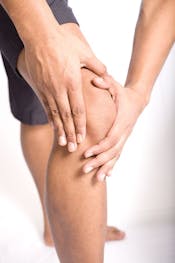By: Jill Phelan DPT, PT, Cert. DN
By the time you've made the decision (or you've almost come around to the idea) of having your knee replaced most people have all done the same old song and dance. The pain has reached a chronic state in which discomfort is near daily if not constant with coinciding stiffness and/or swelling. It limits your favorite activities such as golfing, walking, gym classes or even restricts your day-to-day tasks around your home. You've been to your primary care physician or straight to the orthopedic specialist, imaging has shown arthritic degeneration, "bone one bone," and you've likely been through a series of anti-inflammatory injections. The injections may have helped in the past, but now the relief is short term and then you're back to that persistent aching. The recommended next step if you want the reprieve you desire? Knee replacement. So how did it get to this point and what can you expect following the procedure?
The Cause
A few things can contribute to the ultimate wearing of the knee joint. The first and foremost is osteoarthritis, which commonly affects the knee due to the repetitive strain of weight bearing. Over time the cushiony cartilage is damaged and causes friction in two areas, the tibiofemoral joint (where the long femur of the thigh meets the tibia or shin bone) and patellofemoral joint (the union of your knee cap and your femur). This friction causes inflammation and can stimulate bone spurring. Other factors that can contribute to knee erosion are inflammatory diagnoses such as rheumatoid arthritis, past injuries from fractures or sports, faulty congenital alignment as well as the mechanical stress from obesity.
The Procedure
Knee replacements are now one of the most common procedures completed in the realm of orthopedic surgery and typically are very straightforward. The surgeon creates an incision along the front of the knee, exposing the kneecap that he then rotates away to reveal the tibiofemoral joint. Resurfacing is completed to both the damaged distal ends of the femur and tibia and metal components are fitted and secured. He then shifts the patella back in place and may flatten or add an additional piece to the back surface to ensure a proper fit with the rest of the implant. The incision is then closed, bandaged and off to recovery.
Post Op
Depending on co-morbidities or other risk factors some patients are kept 1-2 days in the hospital but many return home within the first day. Most are met with a physical therapist that ensures one can ambulate with a rolling walker (yes, you're walking right away!) and discharged to begin outpatient physical therapy immediately or up to 2 weeks post op when sutures/staples are removed.
Physical Therapy
So what happens now? The first goal upon being evaluated is to manage pain, inflammation and begin mobility. I'll be honest; typically the first 4-6 weeks can be difficult. Despite the damaged knee joint being repaired, surgery is still trauma and your bodies natural healing factors are at high alert. Most experience moderate swelling, stiffness and pain that makes it difficult to sleep or stay in one position for too long. This is all normal, however! As I have told my patients in the past, most if not all patients go through this to some extent and it can be frustrating. This will subside in the first weeks and one starts noticing steady gains in strength, walking tolerance, decreased reliance on assistive device, balance and ability to transfer and climb stairs. Along with pain and inflammatory management, one of the first priorities is to achieve normal mobility, particularly full knee extension. The reasoning of trying to get the knee straight is to aid in normal walking and stair climbing without compensation or appearance of a limp. Due to high level of healing, despite pain this is of utmost importance to prevent faulty scar tissue to form around the knee capsule and limit knee movement long term. In conjunction with full lower extremity strengthening, emphasis on flexibility and balance are also integrated to ensure knee stability and control with return to dynamic tasks such as walking on uneven or sloped surfaces. Our goals as physical therapists are to manage the aforementioned symptoms associated with post op process and get you back to the activities that you have missed out on due to chronic knee dysfunction. Rehab after a joint replacement surgery such as your knee can be a longer process that one can expect depending on each individuals limitations and it pays to have a trusted physical therapist by your side to guide you in the right direction en route to your future aspirations. We at PRS are more than qualified and happy to help you in this journey!
So if you or someone you know would like to know more about physical therapy options post total knee replacement or for a variety of musculoskeletal and neuromuscular conditions, seek the consultation of a physical therapist at one of our six locations or see your physician for a referral to one of our facilities. Our newest location in Little River, is now accepting patients! For further information on this or other related topics you can contact Richard A. Owens, PT, MS, OCS, Cert. SHT, CWcHP, Cert DN (Surfside) (843) 831-0163 and (Murrells Inlet) (843) 314-3224, Richard DeFalco, DPT, OCS, CSCS, CWcHP, Cert. DN (Myrtle Beach) (843) 839-1300 and (Little River) (843) 281-4222, Jill Phelan, DPT, Cert. DN (Conway) (843) 733-3031 and (Little River) or Brian P. Kinmartin, PT, DPT, MTC, OCS, STC, CWcHP, Cert. DN (Pawley's Island) (843) 235-0200 or visit our website at www.prsrehabservices.com where you can learn more about the company and even download a referral form for your physician to fill out. You can also call and schedule a free 15-minute consultation!

